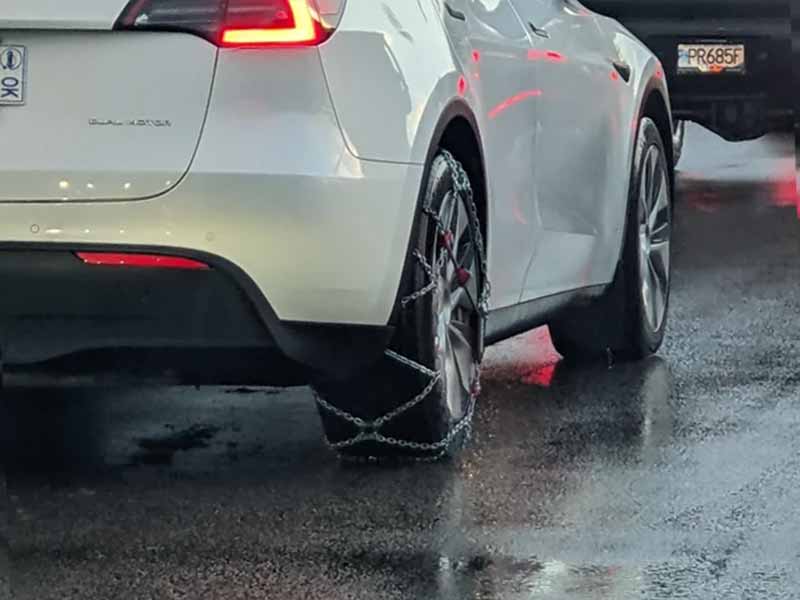Are you prepared for safe winter driving? Understanding tire chain laws by state could be the key to ensuring your safety and compliance while navigating snowy roads. Discover how these laws affect your travels and safety.
Tire Chain Laws By State
Tire chain laws vary by state, impacting when and where you need them for safe winter driving.
State Tire Chains Allowed? Restrictions (if any) Alabama Yes No specific restrictions* Arizona Yes No specific restrictions* California Yes Signs posted when required Colorado Yes Commercial vehicles carry chains from Sept 1 – May 31 Connecticut Yes (Studded tires & non-skid devices from Nov 15 – April 30) Specific dates for studded tires & non-skid devices Delaware Yes No specific restrictions* Florida Yes No specific laws Georgia Yes No specific restrictions* Hawaii Yes No specific laws Idaho Yes No specific restrictions advised unless necessary Illinois Yes No specific restrictions* Indiana Yes No specific restrictions* Iowa Yes No specific restrictions* Kansas Yes No specific restrictions* Kentucky Yes (Ice-covered roads or vehicles with ice shoes 6 in wide) Restrictions on diameter & spacing Louisiana Yes No specific restrictions* Maine Yes No specific restrictions* Maryland Yes (Required when a snow emergency has been declared) Not allowed on vehicles weighing more than 10,000 lbs Massachusetts Yes Permitted from Nov 1-May 1 Michigan Yes No specific restrictions* Minnesota Yes (Permitted when road conditions call for it) Studded pneumatic tires not allowed on state-registered vehicles Mississippi Yes No specific restrictions* Missouri Yes No specific laws Montana Yes (Permitted Oct 1-May 1) Not mandatory unless notices are posted. Specific regulations for studded tires. Nebraska Yes (Metal studs only permitted Nov 1-April 1) School buses, mail carrier vehicles, and emergency vehicles permitted year-round Nevada Yes (Required on all vehicles over 10,000 lbs when requirements in effect) Studded tires permitted between Oct 1-April 30 New Hampshire Yes No specific laws New Jersey Yes No specific restrictions* New York Yes Required when a snow emergency has been declared New Mexico Yes No specific restrictions* North Carolina Yes No specific restrictions* North Dakota Yes No specific restrictions* Ohio Yes (Only permitted between Nov 1-April 1, except for public safety or school bus) Oklahoma Yes No specific restrictions* Oregon Yes (Required on vehicles over 10,000 lbs when SNOW ZONE signs are posted) Pennsylvania Yes (Permitted between Nov 1-April 15) Restrictions on the size of tires or studs Rhode Island Yes No specific restrictions* South Carolina Yes No specific restrictions* South Dakota Yes No specific restrictions* Tennessee Yes (Permitted Oct 1-April 1) Specific regulations on a percentage of wire or other material that comes in contact with the road Texas Yes No specific restrictions* Utah Yes (Between Nov 1-March 31, if signs are posted, vehicles must have chains or snow tires) Vermont Yes No specific laws Washington Yes (Signs marked “chains required” will be posted) On certain routes, chains must be carried from Nov 1-Mar 31 Washington, D.C. Yes No specific laws West Virginia Yes No specific restrictions* Wisconsin Yes No specific restrictions* Wyoming Yes (Signs will be posted indicating when chain laws are in effect) Must use adequate snow tires or chains *Some states have date restrictions, size restrictions, or specific vehicle type restrictions. Check with the state’s transportation department for specifics.
In this article, we’ll explore tire chain laws by state, understanding their importance for safe winter driving. From deciphering state regulations to choosing between snow tires and tire chains, we’ll provide comprehensive insights to ensure a secure and stress-free journey on snow-laden roads.

Understanding Tire Chain Laws for Safe Winter Driving
These regulations aren’t just bureaucratic red tape; they’re designed to protect you and other road users. Being aware of state-specific guidelines and using the appropriate equipment as mandated can make all the difference between a smooth winter drive and encountering unnecessary risks.
Why Tire Chains Matter
- Safety First: Tire chains play a pivotal role in ensuring your vehicle’s traction and stability when roads are covered in snow or ice. They help maintain control, reducing the risk of accidents and sliding.
- Legal Requirements: It’s not just about safety; it’s also the law in many places. States implement tire chain laws to mandate their use during hazardous weather conditions. Failure to comply could result in fines or penalties.
Variations in State Laws
Understanding the specifics of tire chain laws is crucial. These laws vary from state to state, which means what’s permissible in one area might be restricted in another.
- Permission for Chains or Snow Tires: Some states allow the use of tire chains, while others permit the use of specific types of snow tires during wintry weather.
- Restrictions on Studded Tires: Certain states have restrictions or outright bans on studded tires due to their impact on road surfaces or environmental concerns.
- Commercial Vehicle Regulations: Regulations for commercial vehicles might differ significantly from those for personal vehicles, imposing stricter requirements for safety.
Checking State Guidelines
Before setting out on a winter journey, it’s crucial to check the tire chain laws specific to the states you’ll be traversing. This ensures compliance with local regulations and a safer driving experience.
- Resource for Understanding Regulations: Websites offering detailed insights into state-wise tire chain laws can be invaluable. TireGrades provides comprehensive information, aiding in making informed decisions before hitting the wintry roads.
Guidelines for Using Tire Chains Effectively
It’s not just about installing them; it’s about comprehending their function, adhering to state guidelines, and driving cautiously. This knowledge empowers drivers to navigate winter conditions safely, minimizing risks and ensuring a smoother journey through snow-covered roads.
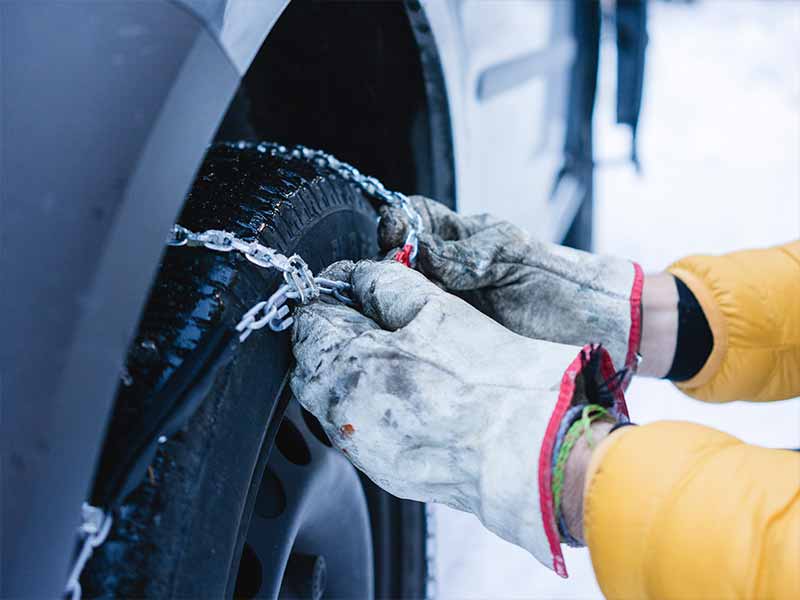
Proper Installation and Usage
- Correct Installation Matters: Properly installing tire chains is paramount for their effectiveness. Follow the manufacturer’s instructions meticulously to ensure a snug and secure fit.
- Knowing When to Use Them: Tire chains are specifically designed for use on snow or ice-covered roads. Avoid using them on dry roads, as this can damage both the chains and your vehicle.
- Understanding Cross Chains: Some tire chains come with cross chains, which enhance traction by providing more contact with the road surface. Understanding their functionality can significantly improve traction.
Making Informed Decisions
- Utilizing Adequate Snow Tires: In some states, having adequate snow tires with the appropriate tread depth might suffice, eliminating the need for tire chains. TireGrades offers insights into the efficiency of snow tires versus tire chains, aiding in making informed decisions.
- Cross-Checking State Guidelines: Always cross-check state-specific guidelines regarding tire chain usage. While some regions mandate tire chains during certain weather conditions, others might allow snow tires with adequate tread depth.
Effectiveness and Safety
- Enhanced Traction and Safety: When used correctly, tire chains significantly enhance your vehicle’s traction and maneuverability, reducing the likelihood of skidding or losing control on slippery surfaces.
- Driving with Caution: Despite having tire chains, driving cautiously is imperative. Reduced speeds, gentle acceleration, and braking help maintain control and ensure safety, even with tire chains in place.
State-by-State Tire Chain Regulations
Understanding the variations in regulations, whether chains or snow tires are required, and prioritizing safety through compliance with these laws can make a substantial difference in ensuring a secure and stress-free journey on snow-laden roads.
Varying Regulations Across States
- Diverse Approaches: States have varying laws regarding the use of tire chains. Some may require them in specific weather conditions, while others might permit alternative options like snow tires.
- All-Wheel Drive Vehicles: Certain states may exempt all-wheel drive vehicles from using tire chains due to their enhanced traction capabilities. However, this might not be the case universally.
Navigating Different State Laws
- Understanding Chain vs. Snow Tire Laws: Some states mandate the use of chains under certain conditions, while others allow the use of snow tires meeting specific requirements. TireGrades offers a detailed comparison between snow tires and chains, aiding in making the right choice based on state regulations.
- Commercial Vehicle Regulations: It’s crucial to note that regulations for commercial vehicles might differ significantly from those for passenger vehicles, often requiring stricter compliance for safety reasons.
Prioritizing Safety and Compliance
- Safety First Approach: Regardless of state regulations, prioritizing safety is paramount. Even if not mandated, using tire chains or appropriate winter tires during harsh weather conditions ensures safer travels.
- Checking State-Specific Guidelines: Before embarking on a winter journey, always check state-specific guidelines to ensure compliance. These regulations are designed to enhance safety and minimize risks during challenging road conditions.
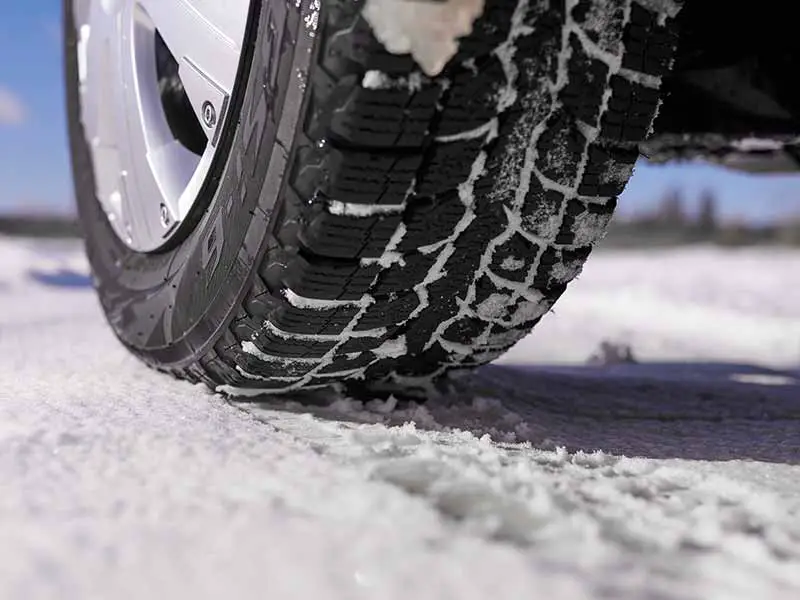
Importance of Adequate Snow Tires in Winter Conditions
Adequate snow tires are a fundamental component of safe winter driving. Their ability to provide enhanced traction, maintain performance in cold weather, and often replace the need for tire chains underscores their importance. Understanding the advantages of snow tires, complying with state laws, and maintaining them properly can significantly contribute to a safer and smoother driving experience in snowy conditions.
The Efficacy of Snow Tires
- Enhanced Traction: Snow tires are specifically designed with deeper treads and unique rubber compounds to provide better traction on snow and ice-covered roads, offering improved grip and handling.
- Superior Performance in Cold Weather: Unlike all-season tires, snow tires maintain their flexibility and grip in colder temperatures, crucial for safe driving in wintry conditions.
Understanding Snow Tires vs. Chains
- Alternatives to Tire Chains: In certain states, using snow tires that meet specific requirements may eliminate the need for tire chains altogether. Understanding the effectiveness of snow tires versus chains is vital. TireGrades provides a detailed comparison, aiding in making informed decisions based on individual needs and state regulations.
- Legal Compliance and Safety: Utilizing adequate snow tires not only ensures compliance with state laws but also prioritizes safety by offering reliable traction and control in snowy or icy conditions.
Choosing the Right Snow Tires
- Tread Depth and Quality: When selecting snow tires, consider tread depth and quality. Tires with deeper treads provide better traction, especially in deeper snow.
- Proper Maintenance: Regularly checking and maintaining snow tires ensures their effectiveness throughout the winter season, improving overall safety on wintry roads.
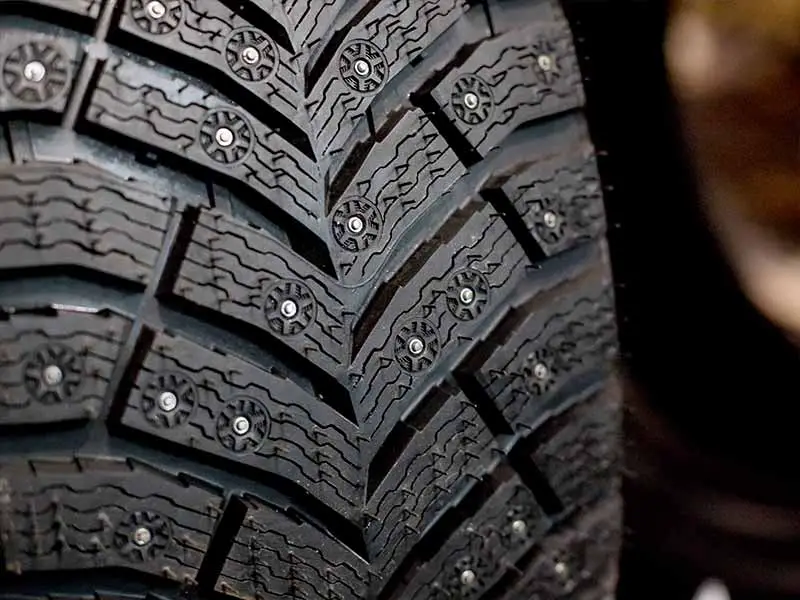
Exploring the Role of Studded Tires in Winter Driving
Studded tires present an attractive option for enhanced traction on icy roads, but their usage is often governed by state regulations due to concerns about road damage and environmental impact. Understanding the advantages and limitations of studded tires, as well as the regulations in your area, empowers drivers to make informed decisions for safer and more responsible winter driving.
Understanding Studded Tires
- Enhanced Grip on Ice: Studded tires feature metal studs or pins embedded in the tire tread, providing increased traction on icy surfaces by biting into the ice for better grip.
- Legal Restrictions in Some States: However, it’s important to note that some states have restrictions or outright bans on studded tires due to concerns about road damage or environmental impact.
Evaluating Studded Tires vs. Chains
- Traction and Performance: Studded tires excel in icy conditions, offering exceptional traction. Yet, they might not be universally allowed, and in some cases, chains may be a more viable option. Understanding the differences between studded tires and chains is crucial for making the right choice. TireGrades offers a detailed comparison for informed decision-making.
- Consideration of State Laws: Knowing the regulations in your state regarding studded tires is imperative. While they provide excellent grip, some regions may have restrictions or limitations on their usage.
Making Informed Choices
- Environmental Impact: It’s essential to consider not only the traction benefits but also the potential environmental impact of studded tires. Some areas restrict their use to minimize road damage and environmental concerns.
- Adherence to State Regulations: Ensuring compliance with state laws regarding studded tires not only prevents legal issues but also contributes to responsible driving practices.
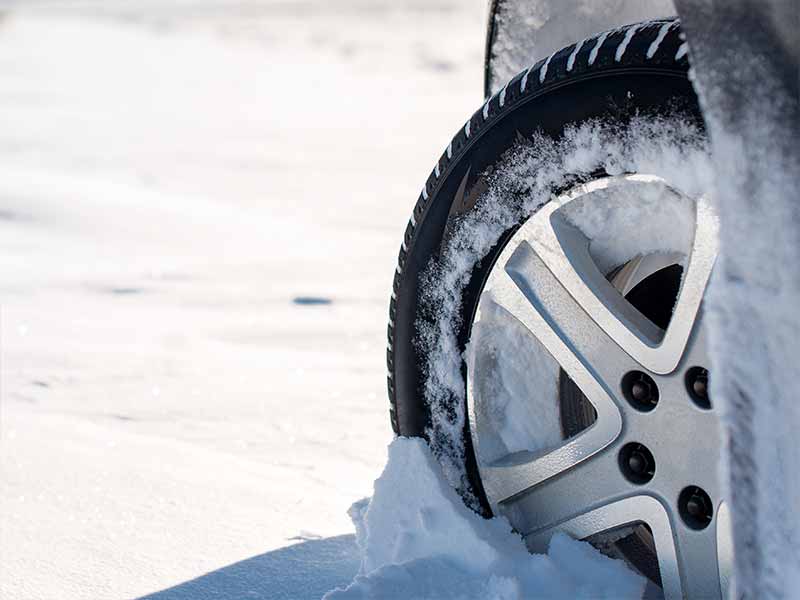
Snow Tires vs. All-Wheel Drive: Making Informed Winter Driving Choices
Choosing between snow tires and an AWD vehicle for winter driving isn’t necessarily an “either-or” scenario; rather, it’s about understanding their individual roles. Snow tires offer superior traction and control on wintry roads, while AWD vehicles provide enhanced forward motion. Combining both solutions ensures a safer and more confident driving experience during winter months, offering a balanced approach to tackle challenging road conditions.
The Role of Snow Tires
- Traction and Performance: Snow tires are specifically designed with deeper treads and unique rubber compounds to provide better traction on snow and ice-covered roads, enhancing grip and handling in challenging conditions.
- Effective in Cold Weather: Snow tires maintain flexibility and grip even in cold temperatures, offering superior performance compared to all-season tires.
Understanding All-Wheel Drive (AWD)
- Enhanced Traction: AWD vehicles distribute power to all four wheels, improving traction and stability. While beneficial, AWD primarily aids in forward motion and does not necessarily enhance braking or cornering abilities on icy roads.
- Complementary to Snow Tires: AWD can work synergistically with snow tires, offering superior traction and control, especially in challenging winter conditions.
Making the Right Choice
- Complementary Solutions: The ideal scenario involves combining snow tires with an AWD vehicle for maximum traction and safety during winter. This combination offers both enhanced traction and control.
- Understanding Limitations: While AWD vehicles provide improved traction, they do not substitute for the traction benefits provided by snow tires on snowy or icy roads.
Resources
Below are some links you may find helpful when learning about tires:
- Winter Driving Tips for Staying Safe on the Roads – AAA
- Understanding Snow Tire Regulations – Consumer Reports
Final Thoughts
Understanding tire chain laws by state is pivotal for safe winter driving. Complying with these regulations and choosing appropriate tire options, such as snow tires or chains, significantly enhances traction and control on snow-covered roads. Remember, prioritizing safety and compliance with state laws ensures a smoother and more secure journey during challenging winter conditions.
Good luck and happy motoring.
